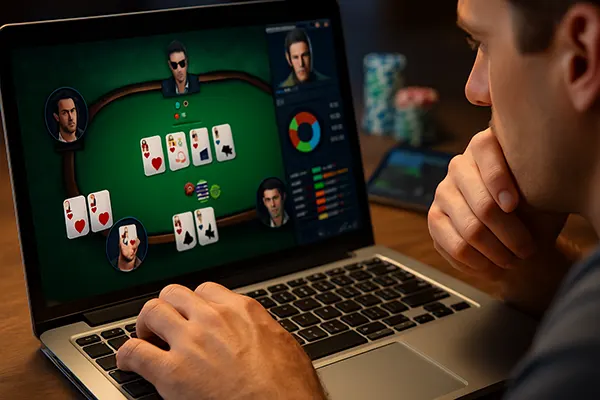
Reading Tells in Online Poker: Can You “Read” an Opponent Without Live Contact?
In traditional poker, players often rely on body language, facial expressions, and physical cues to gain an edge. But how does this translate to online poker, where all that’s visible is a username and a betting pattern? Many experienced players argue that tells still exist — just in different forms. In the online environment, recognising patterns, reaction times, and behaviour under pressure has become the modern way to “read” your opponents.
Behavioural Patterns and Timing Tells in Online Poker
One of the most reliable indicators in online poker is the speed at which players act. A rapid check might indicate weakness, while a sudden long pause followed by a big bet may suggest a bluff. Over time, players develop patterns, and observant opponents can use those to their advantage. Timing tells, while subtle, become more accurate the longer you play against the same opponent.
Another tell comes from bet sizing. If a player usually bets a small amount but suddenly places an oversized raise, it may signal a strong hand — or a bluff. Consistency in behaviour is key; once broken, it stands out. Combining timing and bet sizing gives players an edge in decoding intentions without any physical presence.
Additionally, reaction to pressure is a revealing tell. In tournaments, watch how opponents behave as the bubble nears or in high-pressure spots. Passive players may suddenly become aggressive, indicating nerves. Emotional responses manifest through erratic betting or poor decisions, giving observant opponents an edge.
Identifying Multitabling and Distraction Tells
In online poker, many players are involved in multiple games simultaneously. If a player regularly takes a long time to act in early positions but responds instantly in later ones, it might indicate multitabling. This inconsistency helps identify distractions that could be exploited strategically.
Another key indicator is erratic gameplay. Sudden delays followed by fast plays, or inconsistent betting patterns, may suggest the player is distracted. These aren’t always signs of weakness, but they indicate a shift in attention. Recognising these changes can offer a timing advantage.
Finally, chat behaviour is occasionally a tell. While rare in modern poker rooms, some players still engage in table chat. Frustration, overconfidence, or attempts at manipulation via messaging can hint at tilt or desperation. Smart players read not just the cards, but the conversations too.
The Role of HUDs and Statistics in Reading Opponents
Heads-Up Displays (HUDs) have revolutionised the online poker scene. These tools provide real-time stats on opponents, including their VPIP (Voluntarily Put Money in Pot), PFR (Pre-Flop Raise), and aggression factors. By tracking thousands of hands, players can spot statistical anomalies that may serve as digital tells.
A player with an extremely high VPIP, for instance, likely plays loosely and could be exploited with stronger ranges. Conversely, those with low aggression frequencies are often tight and passive. Reading into these numbers is as critical as spotting facial expressions in live games. The data tells a story — the key is learning how to interpret it correctly.
Moreover, long-term statistics reveal more than isolated hands. If a player consistently folds to three-bets, it becomes a valuable insight. Tools like PokerTracker and Holdem Manager turn raw data into actionable reads, allowing skilled users to play highly informed, strategic poker.
Exploiting Regulars vs. Casual Players
Regular players usually have solid stats and standardised strategies. To exploit them, you need deeper reads — such as their tendencies in marginal spots or their behaviour against specific stack sizes. These micro-patterns often become predictable over long sessions.
In contrast, casual players are less consistent. They might limp with strong hands or chase draws aggressively. Their unpredictability makes statistical reading harder, but watching for exaggerated bet sizes or inconsistent timing can provide critical insights. Casuals are more prone to tilt and emotional play, which can be exploited.
Identifying who you are playing against — a regular or a casual — is the first step. The second is adjusting your strategy to exploit their typical tendencies. This adaptability is what separates a good player from a great one in online formats.

Adapting to New Trends in Online Poker Behaviour
The online poker landscape is constantly evolving. With the growth of short-handed tables, fast-fold formats, and anonymous play, traditional tells are changing. Players now adapt by observing less and acting more on population tendencies. These trends demand flexibility and modern interpretation of behaviour.
In fast-fold games, for example, timing tells become harder to read due to randomised seating. Instead, players rely on game flow and standard tendencies. It’s no longer about reading *a* player but reading *the* player pool. Adapting to this requires a shift from micro-analysis to broader strategy.
Increased use of solvers and training sites has also changed how players behave. Many now mimic GTO (Game Theory Optimal) patterns, making traditional reading harder. However, very few play true GTO, and deviations still appear under pressure. Exploiting these deviations remains possible for players who combine data, observation, and experience.
Future of Online Tells and AI Detection
As AI detection systems grow more advanced, so does the ability to identify patterns in real time. Poker platforms now use AI to detect bots, collusion, and suspicious play. However, this same technology can help players find tells — by using legal tracking tools that analyse behaviour deeply over time.
In the near future, we might see machine learning being used to highlight opponent habits or predict bluffs. While still theoretical for average players, this technology already exists in high-stakes environments and is likely to trickle down. The battle of tells is becoming digital.
To stay competitive, players must not only understand traditional psychology but also embrace data, tech tools, and evolving formats. Reading tells isn’t dead — it’s just gone virtual, and for those who can adapt, it’s still a powerful weapon at the online tables.
